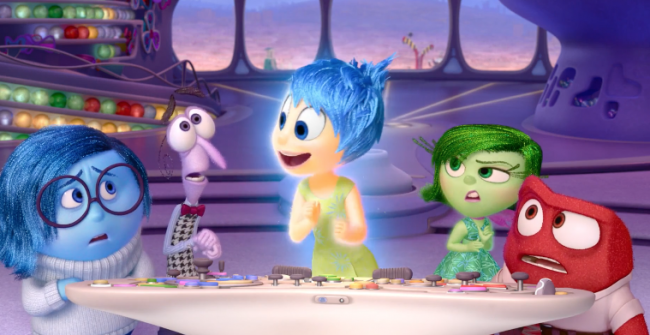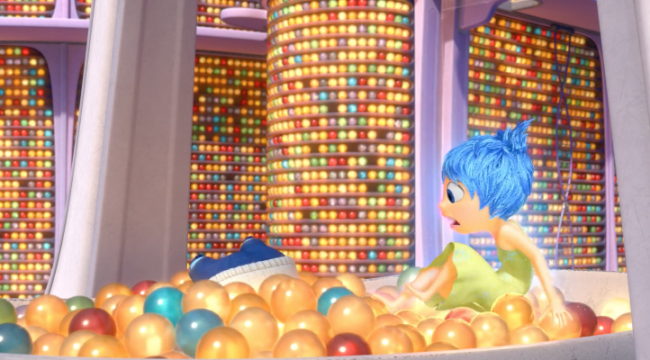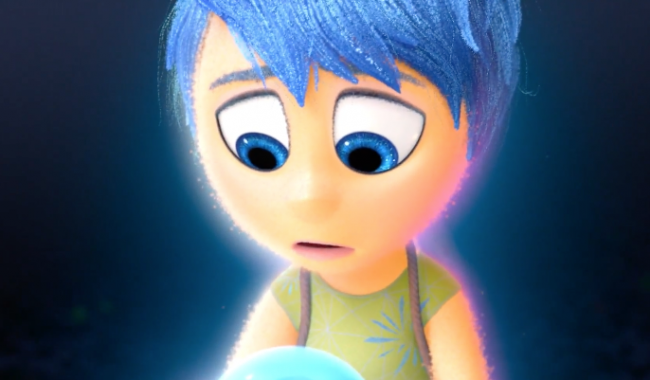That Moment In ‘Inside Out’ (2015): Because of Sadness
A look at this powerful moment in this Pixar classic.

Inside Out is a 2015 animated film about young girl who moves to a new city, dealing with conflicting emotions, of whom five try to save her in her mind.
From the opening tones of Disney/Pixar’s Inside Out, you know something is different, the almost melancholy and yet uplifting chords that introduce the story of Riley, a baby that grows from the indie out sort of speak as we watch from behind here eyes mostly through the varying viewpoints of her anthropomorphized emotions.

They include Anger (Lewis Black), a stout, crimson red figure with a short fuse, Disgust (Mindy Kaling), a green character who appears mostly when broccoli is around, Fear (Bill Hader), a jittery type who does his best to keep Riley safe, and Sadness (Phyllis Smith), a frumpy mournful puff of blue who can’t keep from feeling down. They are all living up in Headquarters (Riley’s brain), where the de facto leader of the group, and the first emotion created, Joy (Amy Poehler) keeps watch over it all, guiding Riley (and us) through the twists and turns of growing up.

One of the most widely critically-praised film in the Pixar canon, often regarded as a return to form for the animation studio after a string of disappointing sequels and lower quality stories, Inside Out was, deservedly so, singled-out as a crowing achievement that delivered a colorful, entertaining tale that was also, for anyone watching, a powerfully (and surprisingly) emotional experience. What’s remarkable about that is how simple the plot is, mostly following an 11-year-old girl who tries to cope with new surroundings after moving to San Francisco with her mom (Diane Lane) and dad (Kyle MacLachlan), and while her story is unique to herself, everything that happens to her is wonderfully, and sometimes heartbreakingly, identifiable for the audience, from school anxieties to imaginary best friends.
Exhaustively researched under consultation from well-known psychologists and emotional experts and psychologists, the film, while limiting and compacting everything to these five basic emotions, deftly handles realistic encounters, layering them with depth not expected in a children’s movie, tapping into what it means to be an adult as much as being a kid. While there are some lapses in the story and a giant loop hole concerning sending core memories back to headquarters, Inside Out is nonetheless a monumental achievement in cinema. And like every movie, has one great moment.
Because Of Sadness
As a kid, Riley (Kaitlyn Dias) loved her life in Minnesota, an only child who enjoyed hockey, had a best friend and not a care in the world. So much so, her core memories are nothing but happiness. However, when her family moves to San Fransisco, that all changes as life in the city is far different, and when a series of circumstances leave things not so stable, she begins to find little joy in her life.

While the gang keeps watch over the control panel that symbolically maintains Riley’s emotional state, it is Sadness that tends to muck things up the most, her compulsive need to touch all memories that flood into headquarters, marble-like balls that are shaded the color of their emotional influence.

Naturally, Joy struggles to stop this, obviously wanting to keep Riley as happy as possible. In fact, all the emotions think this is the way it should be, with Joy being the first on the scene and smiling Riley being the most fun. Sadness, unable to control her impulses though, is eventually confined to a small circle in the room, a chalk outline Joy creates to try and keep her away from the others.

You can guess how well that goes, and after some calamity, not only does Sadness escape her circle, but ends up instigating the worst that could happen as five Core Memories are dislodged, sending them, Joy, and Sadness out of Headquarters and into Long Term Memory, far, far away, out past the “Memory Dump” where memories fade and disappear forever.

To get back and save Riley, whose very personality now threatens to collapse, they must work together since only Sadness, who has read the manuals about Long Term Memory, knows the way. As they travel, they meet a character named Bing Bong (Richard Kind), an imaginary friend of Riley from early childhood wandering about the place who joins the duo in trying to restore Riley back to normal.

Eventually, through some adventures, both Joy, the bag of Core Memories, and Bing Bong end up in the Memory Dump, trapped in the abyss where memories diffuse into oblivion. Holding on to the shining yellow orbs of joy memories, Joy is overcome by the situation, failing to find a way to reach Headquarters and thinking she’s ruined Riley forever.

It is here when she notices one of the spilled Core Memories, now tainted blue after being touched by Sadness, shimmering at her feet and it gets her thinking about all of the fading memories gathered in shadows. She then selects another, a Core Memory that has long been one of the most joyful where Riley celebrates a day of hockey with her family and the little league team she plays for. We learned just earlier, that it as also one of Sadness’ favorite memories as well, which surprised Joy, but now, with that memory in hand, Joy takes a closer look and realizes that while the ending of the memory is happy–the part everyone recalls–it actually started with sadness as Riley’s parents console their daughter after she missed a game-winning shot.

Joy realizes that the value of the memory is not so much the happiness but the combination of it with sorrow, that without the sadness the joy had little meaning. Mom and dad, the team … they all came to help Riley because of sadness. This changes everything for Joy, a sprite who has been from the moment Riley opened her eyes, focused entirely on the need to fill the little girl’s life with unending glee, finding balance with the other emotions while always struggling to keep Riley smiling. This is a hugely significant moment, which leads to a tremendously effective and powerfully emotional moment directly after with Bing Bong (which won’t be spoiled here, but is here).

The lesson here is beautifully drawn as the filmmakers remind that what we are, as we struggle to occupy our lives with happiness even as it is shaped by the sadness, more than the joy but the cohesion of both, each linked by the other, and as we grow older, it is the holding on to these memories that define us. We must allow the bittersweet and the setbacks in our lives to frame as much of what we become as the happiness does, and Inside Out does a remarkable thing by letting what most films push so hard to reject, that feeling sorrow is okay, that it brings us together in ways even happiness cannot, that in fact, without sadness … there might be no joy.
Inside Out remains a sensational experience, filled with great moments of humor and sorrow, an honest and authentic look at a girl moving away from childhood while struggling to hold on to the past, trying to figure out who she is. Led by some truly great voice work by Poehler, this is a timeless family film that respects its audience and earns its place as one of the best movies ever made. And a moment in the dark, where all things become clear, is a great cinematic moment.
